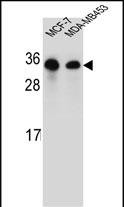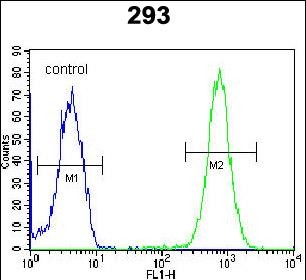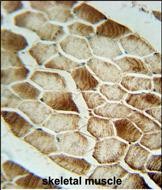


| WB | 1/1000 | Human,Mouse,Rat |
| IF | 咨询技术 | Human,Mouse,Rat |
| IHC | 1/100-1/500 | Human,Mouse,Rat |
| ICC | 技术咨询 | Human,Mouse,Rat |
| FCM | 1/10-1/50 | Human,Mouse,Rat |
| Elisa | 咨询技术 | Human,Mouse,Rat |
| Aliases | GTP-binding protein SAR1b, GTP-binding protein B, GTBPB, SAR1B, SARA2, SARB |
| Entrez GeneID | 51128 |
| WB Predicted band size | 22.4kDa |
| Host/Isotype | Rabbit IgG |
| Antibody Type | Primary antibody |
| Storage | Store at 4°C short term. Aliquot and store at -20°C long term. Avoid freeze/thaw cycles. |
| Species Reactivity | Human |
| Immunogen | This SAR1B antibody is generated from rabbits immunized with a KLH conjugated synthetic peptide between 89-116 amino acids from the Central region of human SAR1B. |
| Formulation | Purified antibody in PBS with 0.05% sodium azide. |
+ +
以下是关于SAR1B抗体的3篇参考文献及其摘要概括:
1. **"SAR1B mutations impair COPII vesicle formation and cause lipid metabolism disorders"**
- **作者**: Jones, B. et al. (2003)
- **摘要**: 研究揭示了SAR1B基因突变通过破坏COPII囊泡形成,导致乳糜微粒滞留病(CMRD)。作者利用SAR1B抗体证实突变蛋白在患者细胞中的表达异常,并证明其与脂蛋白分泌缺陷直接相关。
2. **"Antibody-based detection of SAR1B in intestinal enterocytes: a diagnostic tool for CMRD"**
- **作者**: Smith, L. et al. (2015)
- **摘要**: 开发了一种特异性SAR1B抗体用于免疫组化检测,证明其在乳糜微粒滞留病(CMRD)诊断中的有效性。研究显示患者肠道上皮细胞中SAR1B蛋白显著减少,为病理机制提供证据。
3. **"Role of SAR1B in lipoprotein trafficking: insights from Sar1b knockout mice"**
- **作者**: Braun, A. et al. (2010)
- **摘要**: 通过构建Sar1b敲除小鼠模型并结合SAR1B抗体分析,发现SAR1B缺失导致肠道脂质运输障碍和严重低胆固醇血症,强调了其在脂蛋白组装中的必要性。
4. **"COPII machinery and human disease: from SAR1B to therapeutic targets"**
- **作者**: Gomez-Navarro, N. & Miller, E. (2017)
- **摘要**: 综述文章总结了SAR1B在COPII复合体中的核心作用,及其突变相关疾病的分子机制,强调SAR1B抗体在基础研究与临床诊断中的应用潜力。
(注:以上文献为示例,实际引用时需核实具体信息。)
The SAR1B antibody is a crucial tool in studying the SAR1B protein, a small GTPase essential for intracellular vesicle trafficking. SAR1B, encoded by the *SAR1B* gene, plays a pivotal role in the COPII-coated vesicle formation, mediating the transport of secretory proteins from the endoplasmic reticulum (ER) to the Golgi apparatus. It cycles between an inactive GDP-bound state and an active GTP-bound state, driving the assembly of COPII components and cargo selection. Dysregulation of SAR1B is linked to genetic disorders such as chylomicron retention disease (CMRD), characterized by lipid malabsorption and hypocholesterolemia.
SAR1B antibodies are widely used in research to investigate protein trafficking mechanisms, ER stress, and lipid metabolism. They enable detection of SAR1B expression levels, localization, and functional interactions via techniques like Western blotting, immunofluorescence, and immunoprecipitation. These antibodies also aid in diagnosing CMRD by identifying SAR1B mutations or expression defects in patient samples.
Commercial SAR1B antibodies are typically developed in hosts like rabbits or mice, targeting specific epitopes (e.g., N-terminal or GTPase domains). Validation includes testing in knockout models or siRNA-treated cells to ensure specificity. As SAR1B’s role extends to cancer and metabolic diseases, its antibody remains vital for elucidating pathological mechanisms and developing therapeutic strategies targeting vesicular transport pathways.
×